We may not have the course you’re looking for. If you enquire or give us a call on + 1-866 272 8822 and speak to our training experts, we may still be able to help with your training requirements.
Training Outcomes Within Your Budget!
We ensure quality, budget-alignment, and timely delivery by our expert instructors.
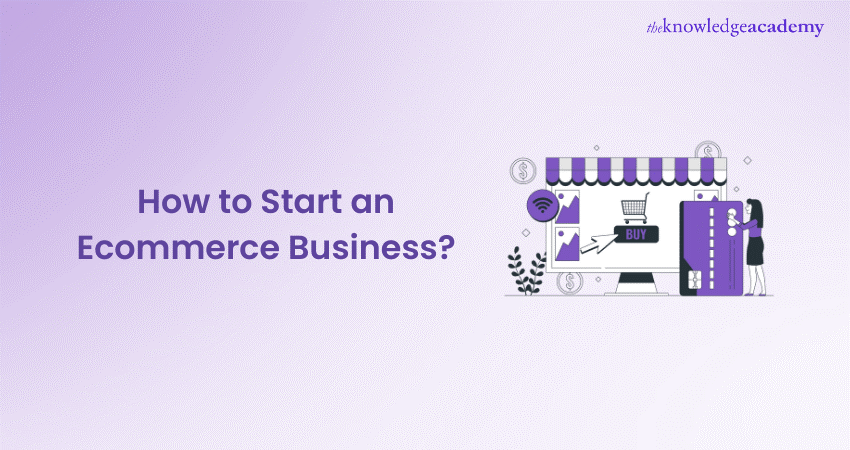
Imagine having the power to run your business and convert casual visitors into loyal customers with the click of the buttons! That's the transformative effect of Ecommerce, turning entrepreneurial dreams into digital realities! Learning How to Start an Ecommerce Business is the gateway to boundless opportunities for innovation, connecting with customers and carving your niche in the lightning-fast online world.
Thanks to the simplicity of online orders and the ease of international shipping, around 52% of global consumers order from local and international websites. So, if you are dreaming of your own business venture, this blog will guide you on How to Start an Ecommerce Business. Read on and gain insight on Ecommerce essentials such as idea research, product sourcing, platform selection, product optimisation and beyond!
Table of Contents
1) What is an Ecommerce Business?
2) How to Start an Ecommerce Business?
3) Why Should You Start an Ecommerce Business?
4) How Much Capital Do You Need to Launch an Ecommerce Business?
5) Tips for Starting an Ecommerce Store
6) Conclusion
What is an Ecommerce Business?
Electronic commerce (or Ecommerce) refers to individuals and companies that buy and sell goods and services over the Internet. Ecommerce operates in diverse market segments and can be conducted on computers, smartphones, tablets, and other smart devices.
Nearly every conceivable product and service is now available through Ecommerce transactions, including music, books, plane tickets, and financial services such as online banking and stock investing.
How to Start an Ecommerce Business?
The following steps will walk you through the simplest approach to starting an Ecommerce Business and setting up an Ecommerce website.
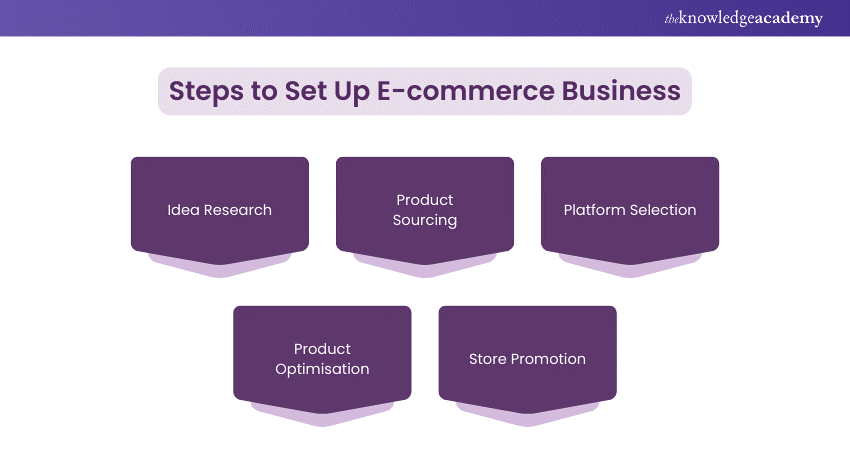
Step 1: Idea Research
Suppose you are starting your Ecommerce journey with a rough idea of what you want to sell. In that case, market research will help you establish your target market's needs, identify competitors, and understand how to stand out from the crowd. There are different ways you can carry out market research. Consider these examples:
a) Set up focus groups with your target market and ask them questions about their needs and wants.
b) Run an online competitor search, which involves analysing their marketing campaigns and noting the research and resources they share online.
c) Read through market reports to identify patterns, spot trends, and explore gaps in the market.
If you are short on budget to conduct your own studies, seek out existing market research, trends data, and reports.
Step 2: Product Sourcing
Once you’ve determined what you'll be selling and your target customer base, the next step is to select the right source for them. Since only good products will help your new online business thrive, the key is not only choosing the right product but the right source as well. Here are a few good options for sourcing Ecommerce products.
a) Resell Existing Products: Reselling involves procuring and reselling products to the end customer for profit. Online listings and directories can help you find suppliers for products. You can contact vendors, order products, and ship them to your business (or storage) location. Then, once the products sell, they are shipped out to customers. Building relationships with suppliers can lead to more affordable procurement and help establish a steady supply chain for your business.
b) Create Products: Compared to other forms of procurement, creating products can give you better control over quality and design. However, this method may be more complicated to scale up. Some sellers prefer to make small batches of handmade products to keep operations manageable and then price products at a premium.
c) Utilise Dropshipping or Print-on-demand: Dropshipping might be your ideal business model if you don’t want to keep inventory in stock. Instead, when an order is placed, a third-party supplier ships it directly to the customer, which allows you to offer various products without investing in a large inventory.
Like dropshipping, the print-on-demand model involves printing products like books or T-shirts after a customer orders. This model might be good for your business if you offer custom designs or unique products that would otherwise be expensive to produce in bulk.
d) Work With a Manufacturer: While partnering with a manufacturer can consume time and resources, the investment might be worth it if you strive for brand building. The proper manufacturer can build prototypes that meet your specifications. You can locate a few manufacturers and ask for samples.
Then, narrow it down to a few and order a small batch to test the manufacturer's speed, quality, and sense of communication. Having a backup supplier is a good option in case something goes wrong. For example, having a supplier in another region can help you maintain stock if there are delays in the supply chain.
Broaden your knowledge base regarding online marketing with our detailed up-to-date Ecommerce Strategy Course – Sign up now!
Step 3: Platform Selection
If you’re new to Ecommerce, starting small and scaling up is advisable. Selling on your website is a good option if you have the time, resources, and skills to customise a website, build a seamless online experience, and compete to bring customers to your virtual doorstep.
Other options include starting on an established Ecommerce website like Amazon or Flipkart or selling through social media sites like Instagram, Facebook, or Pinterest. Let’s explore the details of a couple of these routes:
a) Sell on Existing Ecommerce Website: Ecommerce websites with established traffic can help you engage potential customers, expanding your visibility and reach. Additionally, this strategy enables you to learn what works for other sellers, gain reviews, and generate revenue before investing in your website.
b)Try Social Selling: Social selling enables entrepreneurs to share product information and allows customers to buy during a live show. Customers can see the products, pose queries, and receive real-time personalised recommendations. Social selling can occur on social media or live-streaming destinations and is an interactive way to build customer relationships.
Step 4: Product Optimisation
Once you’ve picked where to sell your products, it’s finally time to get your business up and running. Listing products online is a way to engage customers worldwide with what you are offering. You can manually list products or use systems with spreadsheets and templates to manage your inventory in bulk. But the challenge is ensuring products stand out from the competition in an ocean of offerings. Here are some tips for building competitive product listings:
a) Write descriptively and include critical information to help customers make informed decisions.
b) Ensure that the listing is complete and accurate. This will help in minimising returns and averting negative customer feedback.
c) Put yourself in the customer’s mindset and think about what words or phrases one might type into a search engine to find the product. Then, use Search Engine Optimisation (SEO) to weave keywords into the listings.
Step 5: Store Promotion
There are a variety of ways to get products in front of the right eyes, win over customers, and convert them into buyers. Depending on your selling channels, running marketing and promotional campaigns can help you reach a broader audience.
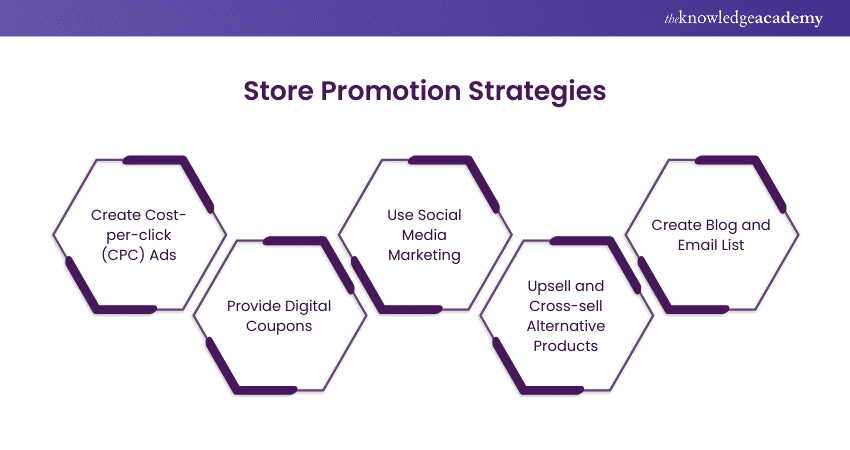
Here’s an overview of the best options to consider:
a) Spread the word about products through targeted cost-per-click (CPC) ads such as Sponsored Products. You can leverage sponsored Brands if you are part of an enrolled brand.
b) Provide special deals, such as digital coupons, lightning deals and seasonal sales.
c) Go for Social Media Marketing to tap into active online communities or engage Social Media influencers.
d) You can upsell or cross-sell products to inform customers about an upgrade or alternative to the product they viewed.
e) Create a blog or email list and send marketing campaigns to build a loyal audience.
Creating visually appealing Product Content and highly opitimised product descriptions are key to succeed in Ecommerce. Want to learn how? Sign up for our Product Content for Ecommerce Training now!
Why Should You Start an Ecommerce Business?
Online purchasing has grown to be the preferred choice for most customers. According to Statista, global Ecommerce revenue is projected to reach £4,914 billion by 2029. Starting an Ecommerce Business is faster than the physical store model and requires far less investment due to the elimination of owning or renting costs for physical space. However, you may still need a storage location for stock.
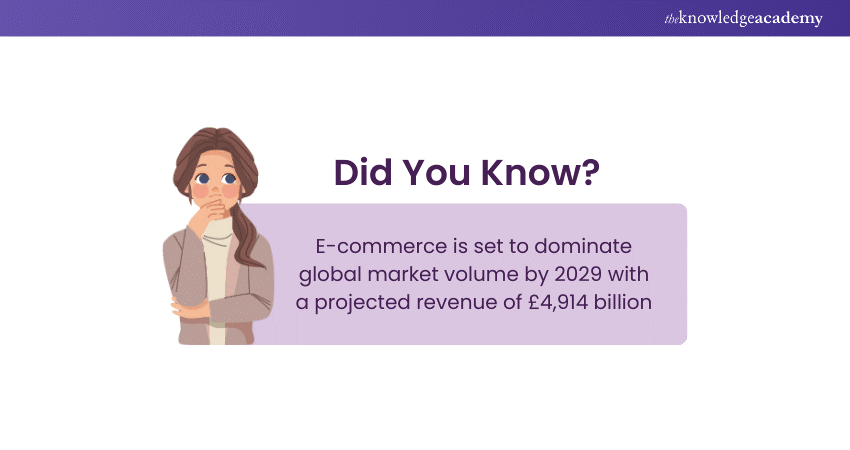
Even though you don’t need to hire retail staff, you could need a helping hand for other digital aspects of the business. If you have internet access, you already have access to many tools and resources to help you succeed in online retailing.
How Much Capital Do You Need to Launch an Ecommerce Business?
The cost of starting an online business and setting up an Ecommerce website depends on various factors such as your business model, product type and range, target market, marketing strategy, and operational expenses. There are some costs that almost every Ecommerce Business will need to cover, including:
1) Stock and manufacturing
2) An Ecommerce platform
3) Order fulfilment, shipping, and logistics
4) Marketing and advertising
5) Staff
Begin by noting all essential costs for starting your business and sum them up to determine how much you’ll need to initiate. Separate the one-off costs (designing a logo) from the ongoing expenses (Ecommerce platform subscription) and use the ongoing costs to create a monthly budget.
Looking to enhance the online presence of your business? Our comprehensive Social Media Marketing Course will ensure that you stay ahead of your competition – Register now!
Tips for Starting an Ecommerce Store
Once you’ve gotten the fundamental requirements of your Ecommerce Business down, you need to setup the Ecommerce store. The following steps will guide you in building an engaging online store
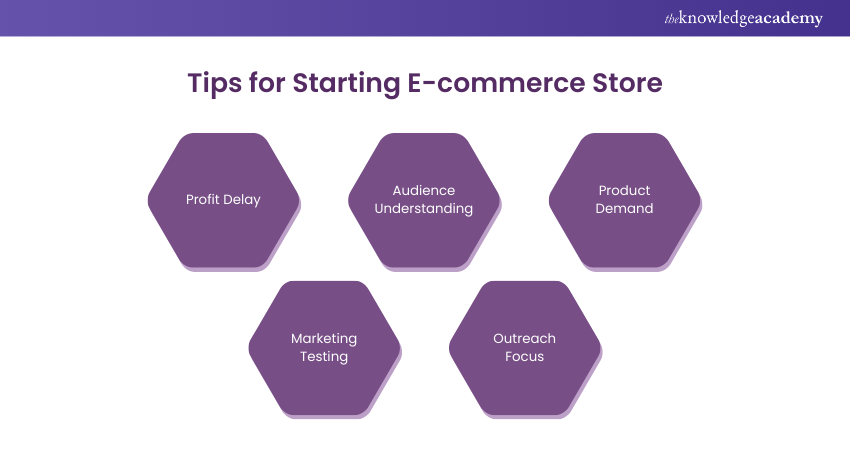
1) Profit Delay
Don’t measure business success by profitability in your very first year. Provide yourself a runway of 18 to 24 months to let your store get off the ground. You can spend your first year testing, reiterating, and reinvesting your sales back into your business using the set budget guidelines.
2) Audience Understanding
Outside of developing or sourcing products, you’ll be spending most of your time trying to get customers' attention. But getting your products in front of the right customers is a challenge. Understanding your target audience is a quick way to reach them and divert them to your store. You can achieve this through relevant content, referral programs, Social Media hashtags, targeted advertising etc.
3) Product Demand
A surefire way to increase sales is to create or sell an amazing product with proven market demand. All the top retailers sell top-tier products. Product quality is vital because a good product basically sells itself. But remember, new products don’t need to be the next big thing. All you need to do is look for growing markets and trends where customers are underserved.
4) Marketing Testing
Getting the word out about your new store after launch is essential. You’ll want to test diverse marketing strategies to understand where your audience hangs out and is responsive to your content. Test different online marketing tactics such as:
a) Instagram ads
b) Affiliate marketing
c) Website pop-ups
d) Organic search
e) Content marketing
f) Loyalty programs
5) Outreach Focus
New Ecommerce store owners and marketers should invest in link-building campaigns and digital public relations early on. The sooner an approach to link-building is in place, the sooner search engines will recognise your website as an authority in its territory. This is the key to long-term SEO success, allowing you to rank higher and earn more organic traffic.
Conclusion
Joining the Ecommerce revolution is not just exciting, it’s an essential aspect of the modern marketing landscape. Ecommerce is on its way to overshadow the concept of physical stores by combining the simplicity online orders with the ease of international shipping. The steps listed in this blog on How to Start an Ecommerce Business will help you set up your Ecommerce store and stand out from your competition in the crowded online world.
Become the master at optimising Ad campaigns with our Google Ads Certification Course – Sign up now!
Frequently Asked Questions

Yes, Ecommerce is profitable and can make you money by selling physical goods, digital downloads or services to customers regardless of location.

With relatively low upfront costs and various great code-free site builders, starting an Ecommerce Business and online store is easier than starting a physical store.

The Knowledge Academy takes global learning to new heights, offering over 30,000 online courses across 490+ locations in 220 countries. This expansive reach ensures accessibility and convenience for learners worldwide.
Alongside our diverse Online Course Catalogue, encompassing 19 major categories, we go the extra mile by providing a plethora of free educational Online Resources like News updates, Blogs, videos, webinars, and interview questions. Tailoring learning experiences further, professionals can maximise value with customisable Course Bundles of TKA.

The Knowledge Academy’s Knowledge Pass, a prepaid voucher, adds another layer of flexibility, allowing course bookings over a 12-month period. Join us on a journey where education knows no bounds.

The Knowledge Academy offers various Digital Marketing Courses, including the Google Ads Certification Course and the Social Media Marketing Course. These courses cater to different skill levels, providing comprehensive insights into What is Content Management.
Our Digital Marketing Blogs cover a range of topics related to Ecommerce, offering valuable resources, best practices, and industry insights. Whether you are a beginner or looking to advance your Ecommerce skills, The Knowledge Academy's diverse courses and informative blogs have got you covered.
Upcoming Digital Marketing Resources Batches & Dates
Date
 Ecommerce Strategy Course
Ecommerce Strategy Course
Fri 8th Nov 2024
Fri 17th Jan 2025
Fri 21st Feb 2025
Fri 4th Apr 2025
Fri 6th Jun 2025
Fri 25th Jul 2025
Fri 7th Nov 2025
Fri 26th Dec 2025







 Top Rated Course
Top Rated Course



 If you wish to make any changes to your course, please
If you wish to make any changes to your course, please


